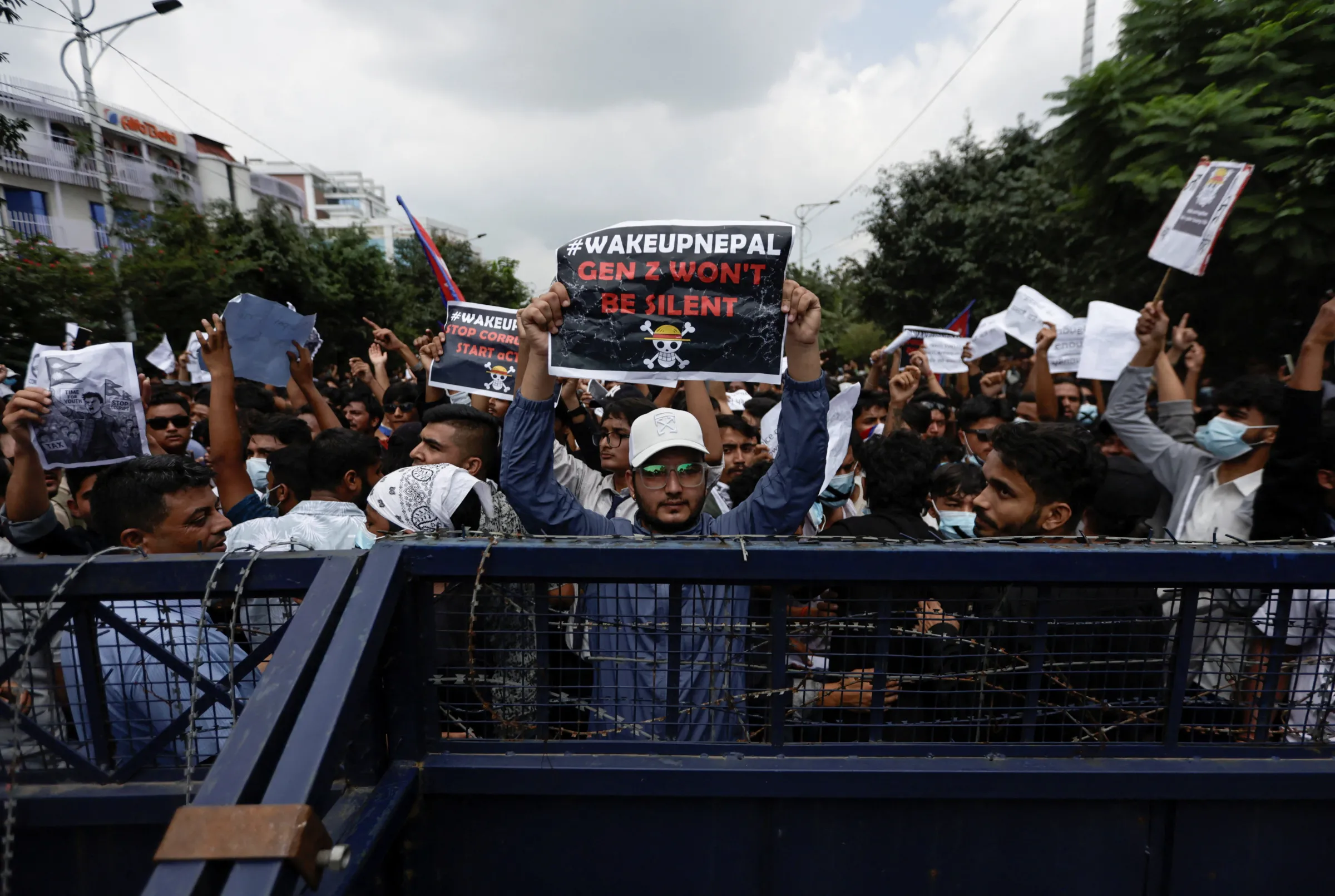How Gen Z toppled Nepal's government

Demonstrators holding placards stand behind barricades during a protest against corruption and the government's decision to block several social media platforms, in Kathmandu, Nepal September 8, 2025. REUTERS/Navesh Chitrakar
What’s the context?
Gen Z protesters pick new leaders for Nepal after deadly demonstrations.
- Former chief justice becomes interim PM
- Elections to be held on March 5, 2026
- Social media plays pivotal role in change
NEW DELHI - From sparking deadly protests to helping pick a new leader, social media is playing a pivotal role in reshaping the Himalayan kingdom of Nepal.
Last week, thousands of Gen Z demonstrators took to the streets in one of Nepal's biggest protests in decades, rallying against a social media ban that authorities eventually repealed.
Flush with their success, activists then used a group chat app called Discord to deliberate on Nepal's new leadership, polling its members and eventually deciding on former chief justice, Sushila Karki, as their new interim leader.
Karki has become the first woman to lead the country after nationwide anti-graft protests killed at least 72 people, and forced the resignation of Prime Minister K.P. Sharma Oli.
Karki, 73, who formally took office on Sunday, is tasked with holding national elections on March 5.
She unveiled cabinet roles on Monday for three figures with reformist and anti-graft credentials to lead the Himalayan nation after violence led to parliament's dissolution.
Here's a look at what went on last week.
What happened at the protests?
Unrest lasting hours led to deaths, injuries and the destruction of property, with police firing tear gas and rubber bullets at rioting protesters.
Government buildings were also set ablaze in the protests, which only subsided after the prime minister resigned.
Businesses set on fire included several hotels in the tourist town of Pokhara and the Hilton in Kathmandu.
The protests, touted as "demonstrations by Gen Z" by organisers, were mostly powered by young people who feel frustrated with politics, poverty and the cost of living.
Many of the demonstrators wore school or college uniforms as they faced police in riot gear.
They said the social-media ban not only muffled their freedom of expression, but also impacted their livelihoods.
Protesters carried the national flag and placards declaring "Shut down corruption and not social media".
Why were social media platforms banned?
In early September, Nepal blocked access to several social media platforms, including Facebook, X and YouTube, after they failed to register with authorities.
The government said social media users had been spreading hate speech and false news and gave social media companies until Sept. 3 to register and name a person responsible for self-regulation, or face shutdown.
The next day, the government told the regulator to deactivate unregistered social media, but gave no details of which platforms faced action.
A communications ministry official told Reuters that TikTok, Viber, WeTalk, Nimbuzz and Poppo Live had registered, but others, including Facebook, had not.
Why were young Nepalis protesting?
Demonstrators said the ban stifled free expression and violated their rights. Critics described it as a tool to censor and punish government critics.
Young Nepalis said they depend on popular platforms such as Instagram and Facebook - with about 14 million users in the country combined - for entertainment, news and business.
They said the ban would have hit businesses that rely on social media to reach customers and sell goods or services.
The protesters were also angry about corruption.
TikTok videos contrasting the tough struggle faced by most in Nepal with the luxuries enjoyed by the "nepo baby" children of politicians gained widespread attention.

Flames rise from the complex that houses the Nepali prime minister's office and other ministries, amid anti-corruption protests triggered by a social media ban which was later lifted in Kathmandu, Nepal, September 9, 2025. REUTERS/Navesh Chitrakar
Flames rise from the complex that houses the Nepali prime minister's office and other ministries, amid anti-corruption protests triggered by a social media ban which was later lifted in Kathmandu, Nepal, September 9, 2025. REUTERS/Navesh Chitrakar
How have authorities reacted?
The government rolled back the social media ban and all the apps were available in Nepal by Tuesday of last week, but there was no letup in the protests until Oli quit later that day.
The unrest was the worst in decades in what is a poor country wedged between India and China. Nepal has struggled with political instability and economic uncertainty since protests led to the abolition of its monarchy in 2008.
Karki has said the government would pay compensation of a million rupees (about $7,100) to the families of those killed in the unrest and provide free treatment to the injured.
She has also asked officials to start rebuilding public structures destroyed in the protests.
This story was updated on Monday September 15, 2025 at 15:37 GMT to include the latest developments.
(Reporting by Annie Banerji, additional reporting by Gopal Sharma; Editing by Jon Hemming and Lyndsay Griffiths.)
Context is powered by the Thomson Reuters Foundation Newsroom.
Our Standards: Thomson Reuters Trust Principles
Tags
- Content moderation
- Internet shutdowns
- Tech regulation

















